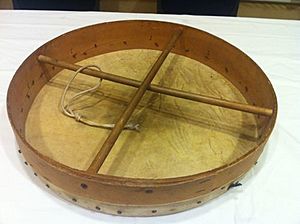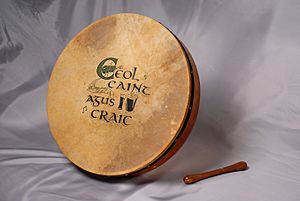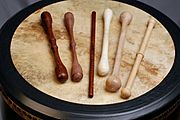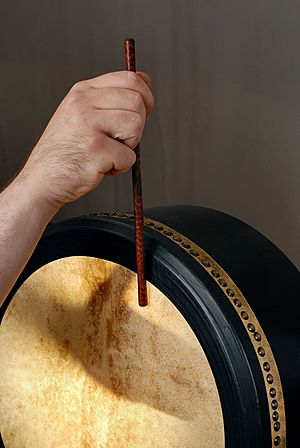Bodhrán facts for kids
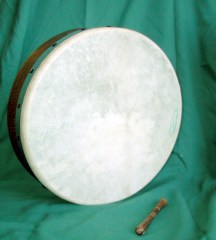
Bodhrán with cipín (tipper)
|
|
| Percussion instrument | |
|---|---|
| Classification | Percussion |
| Hornbostel–Sachs classification | 211.321 (Single-skin frame drums) |
| Developed | Disputed - either mid-20th century or ancient |
| Related instruments | |
| Tambourine | |
The bodhrán (pronounced "BOW-rawn") is a special type of frame drum that comes from Ireland. It's a round drum, usually between 25 and 65 centimeters (about 10 to 25 inches) wide. Most bodhráns are about 35 to 45 centimeters (14 to 18 inches) across. The sides of the drum are about 9 to 20 centimeters (3.5 to 8 inches) deep.
A goatskin head is stretched and tacked onto one side. Sometimes, other animal skins or even synthetic (man-made) materials are used. The other side of the drum is open. This open side allows the player to put one hand inside. This hand can press against the drum head to change the sound. It helps control the pitch (how high or low the sound is) and timbre (the quality of the sound).
Some older bodhráns might have one or two wooden bars inside the frame. These bars helped hold the drum. However, modern bodhráns rarely have these bars. Some professional bodhráns now have special tuning systems. These systems are like those found on other drums. They let you tighten or loosen the drum skin. This is often done with a small tool called a hex key. This helps the drum sound its best in different weather conditions.
Contents
History of the Bodhrán
The bodhrán has an interesting past. Some people think it developed in the mid-1800s. They believe it came from the tambourine. Old Irish music recordings from the 1920s show tambourines being used. A painting from around 1842 also shows a drum that looks like a bodhrán. This painting by Daniel Maclise shows a Halloween party. A musician is playing a drum that looks very similar to a bodhrán.
In some parts of Ireland, people used a "poor man's tambourine." This was made from farm tools and did not have cymbals. It was popular among performers called "mummers." Early in the 20th century, people made drums at home. They used willow branches for the frame and leather for the drumhead. Sometimes, pennies were added as jingles, like on a tambourine.
Some experts, like musician Seán Ó Riada, believe the bodhrán is a very old Celtic drum. They think it might have been used for things like winnowing (separating grain) or drying wool. This would mean its musical history goes back even further, before Christianity.
What Does "Bodhrán" Mean?
The Irish word bodhrán (plural bodhráin) means a drum. It was first written down in an English document in the 1600s. In the late 1700s, it was described as "A drum, tambourine... also a sieve used in winnowing corn."
One bodhrán maker, Caramel Tobin, thinks the name bodhrán might mean "skin tray." He also sees a connection to the Irish word bodhar. This word can mean a dull sound or a drum. It can also mean deaf. The bodhrán is a newer addition to Irish music. It has largely taken the place of the tambourine.
Drums Like the Bodhrán
The bodhrán is a simple drum. Because of this, it is similar to other frame drums found around the world. You can find similar drums in northern Africa and the Middle East. They are also used in Arabic music and in countries around the Mediterranean Sea. For example, the Iranian daf is a larger drum. It is played with fingers, not a stick. Some traditional drums made by Native Americans also look very much like the bodhrán.
Some people think the bodhrán came from skin trays. These trays were used in Ireland to carry peat (a type of fuel). The very first bodhrán might have just been a skin stretched over a wooden frame. The Cornish frame drum called a crowdy-crawn was also used for harvesting grain. It was known as early as 1880.
In the 1950s, a similar drum was seen in parts of England. It was called a "riddle drum." A riddle is a large sieve used to separate soil from stones.
Some historians suggest that until the mid-1900s, the bodhrán was mostly used as a tray. It was used for separating grain, baking, serving food, or storing things. They believe it was only used as a musical instrument for special rituals in the countryside. Its use as a general musical instrument became popular in the 1960s. This was when musician Seán Ó Riada started using it.
When the Bodhrán Became Popular
There are no known mentions of the name "bodhrán" for a drum before the 1600s. Drums have been used in Ireland for a long time. However, the bodhrán itself did not become widely known as a musical instrument until the 1960s. This was during a big comeback for Irish traditional music. Bands like Ceoltóirí Chualann and The Chieftains helped make the bodhrán famous.
As interest grew, recordings of Irish music became available worldwide. This made the bodhrán known around the globe. In the 1970s, talented players like Robin Morton, Peadar Mercier, Christy Moore, and Johnny "Ringo" McDonagh made new ways of playing the bodhrán.
Bodhrán Around the World
The bodhrán is most common in Ireland. But it has also become popular in other places with Celtic music. This includes Scotland, Cape Breton in Canada, and parts of Newfoundland and Prince Edward Island. In England, similar drums called "riddle drums" were used with traditional dance music. In Cornish traditional music, they are called a crowdy-crawn. The bodhrán is also used in the Celtic music of Galicia, Spain. It often plays along with the gaita gallega (Galician bagpipes).
Beaters for the Bodhrán
The bodhrán is played by hitting it. You can use your bare hand. Or you can use a special wooden stick called a bone, tipper, beater, or cipín.
Tippers were first made from a knuckle bone. Today, they are usually made from wood like ash, holly, or hickory. Some players, like Johnny McDonagh, started using beaters with brushes on the end. They also developed a "rim shot" technique. This is where you hit the rim of the drum for a different sound.
How to Play the Bodhrán
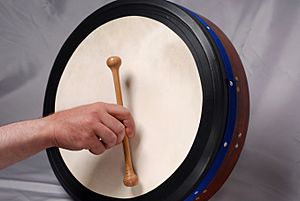
Players usually sit down to play the bodhrán. They hold the drum upright on their thigh. Their upper body and arm support it. For a right-handed player, the drum is usually on the left side. The player's left hand goes inside the drum. This hand presses on the skin to change the tension. Changing the tension changes the pitch and sound quality. It also controls how much of the drum's surface is played.
The other arm (usually the right) hits the drum. This can be with the bare hand or a tipper. There are many ways to play the bodhrán. These styles are often named after the part of Ireland where they started. The most common is the Kerry style. This uses a tipper with two ends. The West Limerick style uses only one end of the tipper.
Later players developed advanced ways to change the pitch. This allowed them to follow the tune being played. This new way of playing is called the "top-end" style. Many new players learn this style today. This style often uses a smaller drum (14–15 inches) that is deeper (4–6 inches). It also has a thinner skin, like a Lambeg drum. The tipper for this style is usually straight. Most of the playing happens at the top of the drum.
In this style, the hand inside the drum moves. It goes from the bottom towards the top of the drum. This creates higher pitches. By making a "C" shape with the hand, the player can make the sound louder. This allows the bodhrán to play more like a melody instrument. It can make many different sounds.
When playing the bodhrán with Irish music, different beats are used. For example, reels have a 4/4 time. The bodhrán player must keep this rhythm. But they can also add their own touches. They might emphasize the first beat, like ONE two three four. Or they can add quick, short beats. This makes the playing more interesting. It also helps the bodhrán fit well with the other instruments. The bodhrán can sound very expressive, almost like a melody instrument. This is because of the pitch changes and different sounds from the animal skin.
New Ways to Play
Playing styles have changed with new inventions. One important change was the internal tone ring. This system tightens or loosens the skin with screws. It was invented by Seamus O'Kane in 1976. He wanted to solve the problem of damp weather affecting the drum's sound. This idea came from banjo design.
At first, only a few of these drums were made. But then other drum makers started using and improving the system. Now, makers all over the world use it. This invention changed how bodhráns are made and played. It means the weather no longer affects the drum's tension. Seamus O'Kane also introduced the idea of using thin Lambeg skins. This allowed the bodhrán to make both higher and lower clear notes. It helped players become more musical and gentle in their playing.
Changing Your Bodhrán
It is common for players to put electrical tape around the rim of their bodhrán. This can be done by the drum maker or the owner. The tape helps to stop vibrations from bouncing back from the rim. It also helps to quiet unwanted extra sounds. This gives the player more control over the drum's sound. Electrical tape is good because its glue stretches with the skin. This means it stays smooth even when the skin tension changes.
Owners of drums with thick or rough skins might also lightly sand the skin. This makes it smoother. It reduces the scratching sound when the tipper hits the drum. Many of these changes can also happen naturally. A drum's sound can improve with regular use over time.
As music from different cultures has become more popular, new playing styles have come to the bodhrán. These styles were once used with other types of drums.
The World Bodhrán Championships are held every year in Milltown, County Kerry, Ireland.
See also
 In Spanish: Bodhrán para niños
In Spanish: Bodhrán para niños


